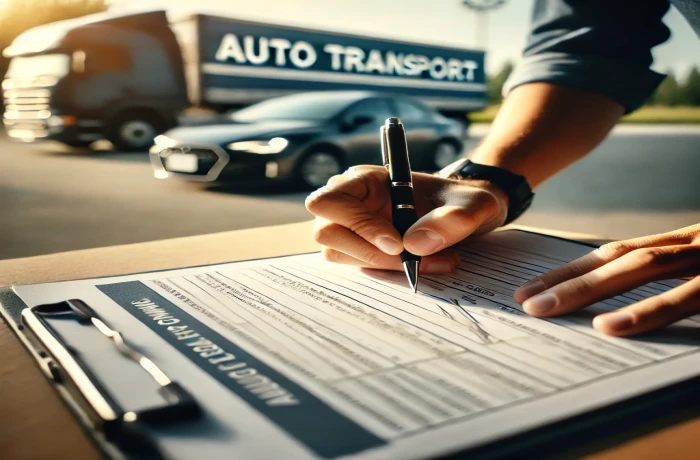Auto Transport Bill of Lading: Everything You Need to Know

Lila Claybourne
Oct 06, 2024

The auto transport process involves various steps, but one of the most important is the Bill of Lading (BOL). This document plays a critical role in ensuring smooth and legally sound vehicle transportation. A Bill of Lading is not just a piece of paper; it serves as a receipt, a contract, and a report of your vehicle’s condition, all while offering legal protection to both parties involved.
In this article, we will dive into the Bill of Lading, explaining what it is, its significance in auto transport, the information it contains, and its role throughout the shipping process. We will also delve into the various types of BOLs and provide some useful tips for handling the document. Finally, we’ll address frequently asked questions to offer a comprehensive guide for vehicle owners preparing to ship their cars.
What is a Bill of Lading?
A Bill of Lading (BOL) is a legal document provided by the carrier to the vehicle owner at the start of the auto transport process. It functions as the official record of the agreement between the two parties and contains all relevant information about the vehicle, transport details, and condition at pickup and delivery.
The BOL plays three critical roles:
Receipt: It acts as proof that the carrier has received the vehicle for transport.
Contract: It serves as a legally binding agreement between the vehicle owner and the carrier.
Condition Report: It provides an inspection record of the vehicle’s state before and after shipping, helping settle any disputes.
For more on ensuring the safety and accuracy of your transport, check out how to document a car’s condition.
Importance of the Bill of Lading in Auto Transport
1. Proof of Vehicle Condition
One of the primary purposes of the BOL is to document the vehicle’s condition at pickup and delivery. This inspection report includes any visible damage (scratches, dents, etc.), and it’s crucial in resolving any claims for damage that may occur during transportation.
2. Legal Protection
The BOL acts as a legal safeguard, binding both the carrier and the vehicle owner to the terms and conditions of the transport. It helps avoid misunderstandings about the vehicle’s condition or the responsibilities of each party.
3. Required for Compliance
During transportation, authorities, such as highway patrols or customs officers, may inspect the BOL to ensure that the vehicle is being transported legally.
4. Essential for Insurance Claims
If your vehicle sustains damage during transit, the BOL is necessary for filing an insurance claim. The document allows a clear comparison between the condition of the vehicle before and after shipping.
Key Information Contained in a Bill of Lading
The Bill of Lading contains essential details that must be carefully reviewed and verified before signing:
Vehicle Information: Includes the make, model, year, and VIN (Vehicle Identification Number).
Shipper and Carrier Information: The names, addresses, and contact details of both parties.
Condition Report: A detailed account of any pre-existing damages.
Terms and Conditions: Outlines the responsibilities, liabilities, and agreements between the vehicle owner and the carrier.
Signatures: Both parties must sign the BOL at pickup and delivery.
How the BOL Works Throughout the Auto Shipping Process
The Bill of Lading plays a crucial role at every stage of the vehicle transport process:
1. Pickup Inspection
Before loading the vehicle, the carrier conducts an inspection with the owner. Both parties check for any pre-existing damage and record it on the BOL. The vehicle owner signs the document, handing over the vehicle for transportation.
2. During Transport
The BOL serves as a manifest for the carrier, listing the vehicles they are responsible for. Authorities may request to see the BOL at weigh stations or checkpoints to verify the legitimacy of the vehicle's transport.
3. Delivery Inspection
Upon delivery, the vehicle is inspected again to compare its condition with the initial report. The vehicle owner and the carrier review the BOL together, and any new damage is noted. Once everything is verified, the vehicle owner signs the BOL, confirming the successful delivery.
In-depth Look at Different Types of Bills of Lading
Several variations of Bills of Lading are used in the auto transport industry, each designed for specific situations. Understanding these types is important for ensuring the correct document is used for your shipment.
1. Clean Bill of Lading
A Clean Bill of Lading indicates that the vehicle was received in good condition at the time of pickup, with no visible damage. This type of BOL is preferred in most cases, as it shows that the car was handed over without any issues. A clean BOL is crucial for the carrier, as it minimizes the risk of disputes over damage claims.
2. Soiled (or Claused) Bill of Lading
A Soiled Bill of Lading records any pre-existing damage to the vehicle at pickup, such as scratches, dents, or other defects. This type of BOL protects both the carrier and the vehicle owner by documenting existing damage, ensuring that new damage can be clearly distinguished from old during the delivery inspection.
3. Shipped Bill of Lading
A Shipped Bill of Lading is issued once the vehicle has been loaded onto the transport vehicle. This document signifies that the transport process has officially begun. It serves as a confirmation that the vehicle has left the pickup location and is en route to its destination.
4. Combined Transport Bill of Lading
A Combined Transport Bill of Lading is used when the shipment involves multiple modes of transportation (e.g., road and sea). For example, if your car is transported by truck to a port and then by ship, this type of BOL would be used. It outlines the various stages and methods of the shipment, ensuring proper coordination between different carriers.
5. Electronic Bill of Lading (eBOL)
In today's digital age, many carriers offer the option of an Electronic Bill of Lading (eBOL). This digital version is becoming increasingly popular due to its convenience and speed. eBOLs reduce paperwork-related delays and help prevent issues like lost documents or fraud. Many transport companies have adopted this system, allowing for electronic signatures and real-time updates on the shipment.
Customer Tips Regarding the Bill of Lading
To ensure a smooth and efficient shipping process, follow these tips:
Inspect your vehicle thoroughly: Before signing the BOL, carefully check the car for any visible damage. Ensure all existing marks, scratches, and dents are recorded in the condition report.
Keep a copy of the BOL: Always retain a copy of the BOL for your records, especially in case of disputes or claims.
Review the terms carefully: Double-check the details of the shipment, including the condition report, pickup, and delivery locations before signing the BOL.
Use electronic options when available: Opt for an eBOL if available to simplify the process and reduce paperwork.
Frequently Asked Questions (FAQs)
What Happens if My Vehicle is Damaged During Transport?
If the vehicle is damaged during transport, the damage should be documented on the BOL at delivery. You will need this documentation to file an insurance claim with your transport company or insurance provider.
Can I Sign the Bill of Lading Electronically?
Yes, many carriers now offer electronic Bills of Lading (eBOL), which can be signed digitally. This option streamlines the process and reduces the chances of document loss or delay.
Is the Bill of Lading Checked by Authorities?
Yes, the BOL may be inspected by authorities during transport to verify the legal status of the shipment. The carrier is required to present the BOL at weigh stations and other checkpoints.
Conclusion: Why the Bill of Lading is Your Key to Safe Auto Transport
The Bill of Lading is a critical part of the auto transport process, serving as a receipt, contract, and inspection report all in one. It ensures legal protection for both the vehicle owner and the carrier, documenting the condition of the vehicle before and after transport. Whether it's a Clean, Soiled, or Combined Transport BOL, each type serves a specific purpose, making it essential to understand the role of this document.
By handling the BOL carefully, inspecting your vehicle thoroughly, and keeping a copy for your records, you can ensure a smooth transport experience. Trust in reliable transport companies like AmeriFreight to ensure a secure and transparent process throughout your vehicle shipment journey.
Related Posts
















